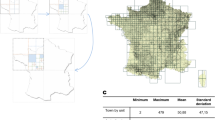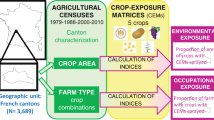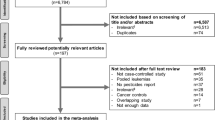Abstract
Occupational exposure to pesticides concerns a wide population of workers not only in agriculture. The reliability of self-reported information on pesticide use is questionable because of the diversity of use. The PESTIPOP job-exposure matrix has been designed to assess pesticide occupational exposure in the general population. The matrix is composed of two axes: the first axis corresponding to jobs (combinations of occupations and industries) and the second one to pesticide exposure. The estimated exposure metric is the probability of exposure coupled with a reliability assessment (low, medium or high). These metrics were defined by combining different sources: (1) an a priori expert assessment (Agricultural industry experts); (2) data from a multicenter case–control study on brain tumors in the general population (occupational history, specific questionnaires); and (3) an a posteriori expert assessment based on the data of a case–control study. So far, 2559 jobs have been identified and 209 (8%) were found to be exposed to pesticides. Jobs with agricultural exposure had a higher exposure probability than jobs with non-agricultural exposure (wood preservation, park maintenance, pest control). Indirect exposure was more frequent than direct exposure. The PESTIPOP matrix will be transcoded into international classifications for use in epidemiological studies.
This is a preview of subscription content, access via your institution
Access options
Subscribe to this journal
Receive 6 print issues and online access
$259.00 per year
only $43.17 per issue
Buy this article
- Purchase on Springer Link
- Instant access to full article PDF
Prices may be subject to local taxes which are calculated during checkout


Similar content being viewed by others
References
Merhi M, Raynal H, Cahuzac E, Vinson F, Cravedi JP, Gamet-Payrastre L . Occupational exposure to pesticides and risk of hematopoietic cancers: meta-analysis of case-control studies. Cancer Causes Control 2007; 18: 1209–1226.
Van Maele-Fabry G, Willems JL . Occupation related pesticide exposure and cancer of the prostate: a meta-analysis. Occup Environ Med 2003; 60: 634–642.
Khuder SA, Mutgi AB, Schaub EA . Meta-analyses of brain cancer and farming. Am J Ind Med 1998; 34: 252–260.
van der Mark M, Brouwer M, Kromhout H, Nijssen P, Huss A, Vermeulen R . Is pesticide use related to Parkinson disease? Some clues to heterogeneity in study results. Environ Health Perspect 2012; 120: 340–347.
Santibáñez M, Bolumar F, García AM . Occupational risk factors in Alzheimer’s disease: a review assessing the quality of published epidemiological studies. Occup Environ Med 2007; 64: 723–732.
Kamel F, Umbach DM, Bedlack RS, Richards M, Watson M, Alavanja MCR et al. Pesticide exposure and amyotrophic lateral sclerosis. Neurotoxicology 2012; 33: 457–462.
Ismail AA, Bodner TE, Rohlman DS . Neurobehavioral performance among agricultural workers and pesticide applicators: a meta-analytic study. Occup Environ Med 2012; 69: 457–464.
Beseler C, Stallones L, Hoppin JA, Alavanja MC, Blair A, Keefe T et al. Depression and pesticide exposures in female spouses of licensed pesticide applicators in the agricultural health study cohort. J Occup Env Med 2006; 48: 1005–1013.
Beard JD, Umbach DM, Hoppin JA, Richards M, Alavanja MCR, Blair A et al. Suicide and pesticide use among pesticide applicators and their spouses in the agricultural health study. Environ Health Perspect 2011; 119: 1610–1615.
Hanke W, Jurewicz J . The risk of adverse reproductive and developmental disorders due to occupational pesticide exposure: an overview of current epidemiological evidence. Int J Occup Med Environ Health 2004; 17: 223–243.
Rocheleau CM, Romitti PA, Dennis LK . Pesticides and hypospadias: a meta-analysis. J Pediatr Urol 2009; 5: 17–24.
Blanc-Lapierre A, Bouvier G, Gruber A, Leffondré K, Lebailly P, Fabrigoule C et al. Cognitive disorders and occupational exposure to organophosphates: results from the PHYTONER study. Am J Epidemiol 2013; 177: 1086–1096.
Baldi I, Lebailly P, Mohammed-Brahim B, Letenneur L, Dartigues J-F, Brochard P . Neurodegenerative diseases and exposure to pesticides in the elderly. Am J Epidemiol 2003; 157: 409–414.
Ji BT, Silverman DT, Stewart PA, Blair A, Swanson GM, Baris D et al. Occupational exposure to pesticides and pancreatic cancer. Am J Ind Med 2001; 39: 92–99.
Allen RH, Mage DT, Gondy G, Kodali A, Christensen C, Coble J et al. Investigation of job-related pesticide exposure in the third national health and nutrition examination survey. Arch Environ Occup Health 2006; 61: 75–86.
Engel LS, Seixas NS, Keifer MC, Longstreth WT, Checkoway H . Validity study of self-reported pesticide exposure among orchardists. J Expo Anal Environ Epidemiol 2001; 11: 359–368.
Hoppin JA, Tolbert PE, Flagg EW, Blair A, Zahm SH . Use of a life events calendar approach to elicit occupational history from farmers. Am J Ind Med 1998; 34: 470–476.
Blair A, Tarone R, Sandler D, Lynch CF, Rowland A, Wintersteen W et al. Reliability of reporting on life-style and agricultural factors by a sample of participants in the Agricultural Health Study from Iowa. Epidemiol Camb Mass 2002; 13: 94–99.
Stewart PA, Prince JK, Colt JS, Ward MH . A method for assessing occupational pesticide exposures of farmworkers. Am J Ind Med 2001; 40: 561–570.
Ihrig MM, Shalat SL, Baynes C . A hospital-based case-control study of stillbirths and environmental exposure to arsenic using an atmospheric dispersion model linked to a geographical information system. Epidemiol Camb Mass 1998; 9: 290–294.
Brody JG, Vorhees DJ, Melly SJ, Swedis SR, Drivas PJ, Rudel RA . Using GIS and historical records to reconstruct residential exposure to large-scale pesticide application. J Expo Anal Environ Epidemiol 2002; 12: 64–80.
Kamińska IA, Ołdak A, Turski WA . Geographical Information System (GIS) as a tool for monitoring and analysing pesticide pollution and its impact on public health. Ann Agric Environ Med 2004; 11: 181–184.
Carles C, Bouvier G, Lebailly P, Baldi I . Use of job-exposure matrices to estimate occupational exposure to pesticides: a review. J Expo Sci Environ Epidemiol 2016.
Nomenclature des Professions et Catégories Socioprofessionnellles PCS. 2e édition, 1994. INSEE: République Française.
Insee - Définitions, méthodes et qualité - Nomenclature d’activités française 1993 [Internet]. [cited 1 June 2016]. Available from http://www.insee.fr/fr/methodes/default.asp?page=nomenclatures/naf1993/naf1993.htm.
Règlement (CE) no 1107/2009 du Parlement européen et du Conseil du 21 octobre 2009 concernant la mise sur le marché des produits phytopharmaceutiques et abrogeant les directives 79/117/CEE et 91/414/CEE du Conseil.
Règlement (UE) n ° 528/2012 du Parlement européen et du Conseil du 22 mai 2012 concernant la mise à disposition sur le marché et l’utilisation des produits biocides Texte présentant de l’intérêt pour l’EEE JO L 167 du 27.6.2012, p. 1–123.
Directive 2004/27/CE du Parlement européen et du Conseil du 31 mars 2004 modifiant la directive 2001/83/CE instituant un code communautaire relatif aux médicaments à usage humain (Texte présentant de l’intérêt pour l’EEE).
Règlement (UE) n ° 1235/2010 du Parlement européen et du Conseil du 15 décembre 2010 modifiant, en ce qui concerne la pharmacovigilance des médicaments à usage humain, le règlement (CE) n ° 726/2004 établissant des procédures communautaires pour l’autorisation et la surveillance en ce qui concerne les médicaments à usage humain et à usage vétérinaire, et instituant une Agence européenne des médicaments, et le règlement (CE) n ° 1394/2007 concernant les médicaments de thérapie innovante Texte présentant de l’intérêt pour l’EEE JO L 348 du 31.12.2010, p. 1–16.
Coureau G, Bouvier G, Lebailly P, Fabbro-Peray P, Gruber A, Leffondre K et al. Mobile phone use and brain tumours in the CERENAT case-control study. Occup Environ Med 2014; 71: 514–522.
Baldi I, Lebailly P, Rondeau V, Bouchart V, Blanc-Lapierre A, Bouvier G et al. Levels and determinants of pesticide exposure in operators involved in treatment of vineyards: results of the PESTEXPO Study. J Expo Sci Environ Epidemiol 2012; 22: 593–600.
Vasama-Neuvonen K, Pukkala E, Paakkulainen H, Mutanen P, Weiderpass E, Boffetta P et al. Ovarian cancer and occupational exposures in Finland. Am J Ind Med 1999; 36: 83–89.
Weiderpass E, Pukkala E, Kauppinen T, Mutanen P, Paakkulainen H, Vasama-Neuvonen K et al. Breast cancer and occupational exposures in women in Finland. Am J Ind Med 1999; 36: 48–53.
Santibañez M, Vioque J, Alguacil J, Barber X, García de la Hera M, Kauppinen T . Occupational exposures and risk of oesophageal cancer by histological type: a case-control study in eastern Spain. Occup Environ Med 2008; 65: 774–781.
Acknowledgements
The study was supported by a grant from the Agence Nationale de Sécurité Sanitaire de l’alimentation de l’environnement et du travail (ANSES) (Project EST-13-164).
Author information
Authors and Affiliations
Corresponding author
Ethics declarations
Competing interests
The authors declare no conflict of interest.
Rights and permissions
About this article
Cite this article
Carles, C., Bouvier, G., Esquirol, Y. et al. Occupational exposure to pesticides: development of a job-exposure matrix for use in population-based studies (PESTIPOP). J Expo Sci Environ Epidemiol 28, 281–288 (2018). https://doi.org/10.1038/jes.2017.26
Received:
Accepted:
Published:
Issue Date:
DOI: https://doi.org/10.1038/jes.2017.26
Keywords
This article is cited by
-
Agricultural activities and risk of Alzheimer’s disease: the TRACTOR project, a nationwide retrospective cohort study
European Journal of Epidemiology (2024)
-
Insights on the bioremediation technologies for pesticide-contaminated soils
Environmental Geochemistry and Health (2022)



